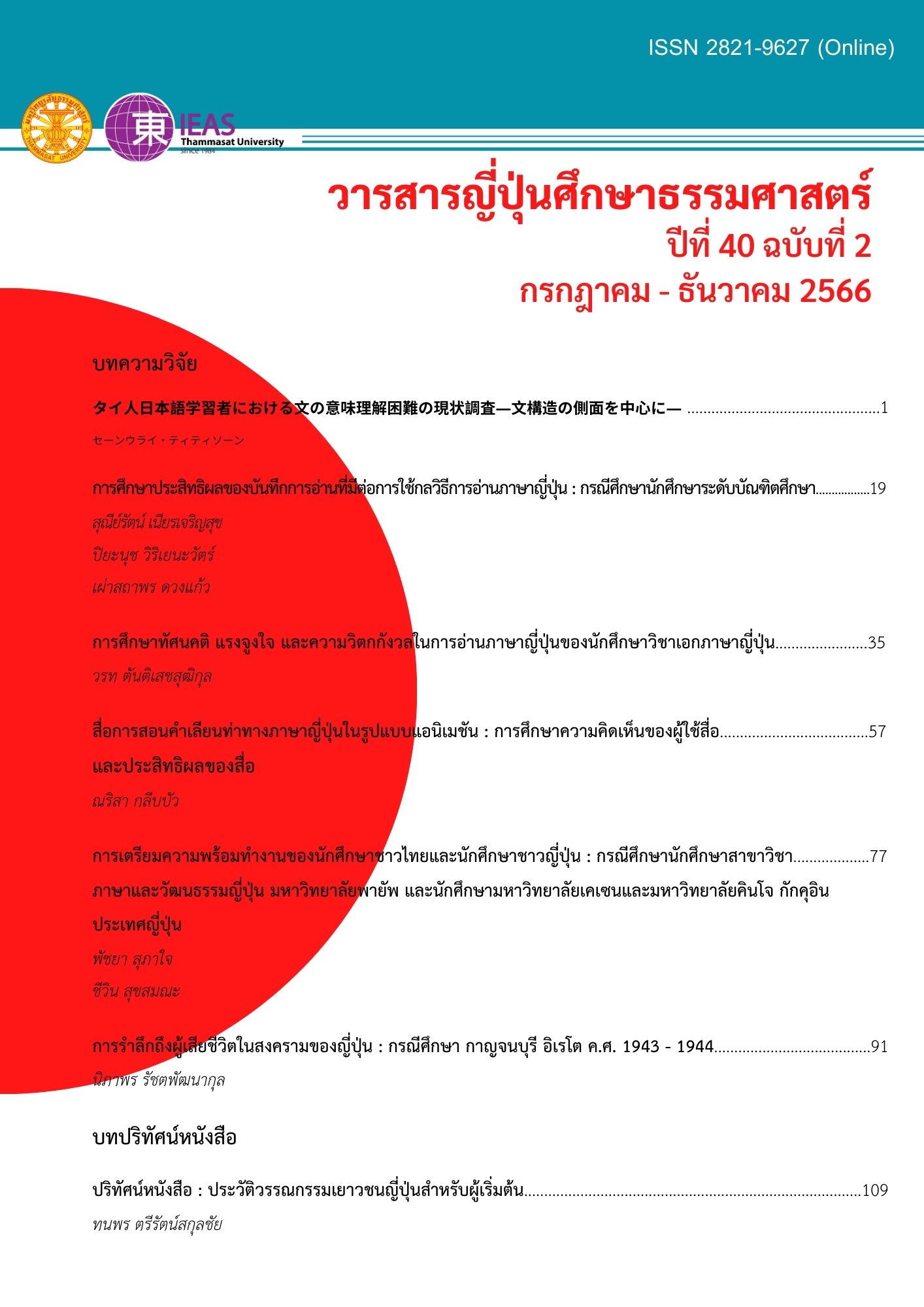The Commemoration of War Dead in Japan: Case study of Kanchanaburi Ireito, 1943 - 1944
Keywords:
Kanchanaburi Cenotaph, Thail-Burma Railway, commemoration, Asian laborers, prisoner of warAbstract
The Kanchanaburi Ireito, also known as the Kanchanaburi Cenotaph, is a memorial site constructed on the orders of the Japanese army in Kanchanaburi province in 1943 during World War II. The site does not have an official Thai name and features various explanations regarding the reasons for its construction. The lack of clarity regarding these basic facts has persisted for over five decades since the end of the war in 1945. This article aims to explore the initial meaning of Kanchanaburi Ireito as a memorial site of the Japanese army in a territory allied with Japan. It studies documents, letters, and analyses under the religious dimension of commemorating those who died in the war. The article proposes that Kanchanaburi Ireito was built under the vision of commemorating war casualties based on Japan’s religious beliefs, which include the concepts of shizume (pacification) and furui (inspiration) along with the ideology of Hakko ichiu (imperial rule over the eight corners of the earth). This ideology promotes a sense of righteousness in Japan’s war efforts.
Downloads
References
กมล ฉายาวัฒนะ. (2511). สุดสัปดาห์ที่แม่น้ำแคว. อ.ส.ท., 8(12), 28-33.
ชัยณรงค์ พันธ์ประชา. (2530). การสร้างทางรถไฟสายมรณะ: ผลกระทบต่อภูมิภาคตะวันตกของประเทศไทย. อักษรศาสตรมหาบัณฑิต (สาขาวิชาประวัติศาสตร์เอเชียตะวันออกเฉียงใต้) มหาวิทยาลัยศิลปากร.
นิภาพร รัชตพัฒนากุล. (2545). ความสัมพันธ์ทางวัฒนธรรมระหว่างไทย-ญี่ปุ่น พ.ศ.2475-2488. ศิลปศาสตรมหาบัณฑิต (สาขาวิชาประวัติศาสตร์) มหาวิทยาลัยธรรมศาสตร์.
นิภาพร รัชตพัฒนากุล. (2549). ประวัติศาสตร์ศาลเจ้ายะสุคุนิในประวัติศาสตร์นิพนธ์ญี่ปุ่น . ใน ทรายแก้ว ทิพากร (บ.ก.), ญี่ปุ่นศึกษา (หน้า 119-140). สถาบันเอเชียศึกษา จุฬาลงกรณ์มหาวิทยาลัย.
พวงทิพย์ เกียรติสหกุล. (2545). วาทกรรมว่าด้วยกองทัพญี่ปุ่นในสมัยสงครามมหาเอเชียบูรพา: ความทรงจำผ่านทางรถไฟสายมรณะ. วารสารอักษรศาสตร์, 31, 74-101.
โยชิกาวา โทชิฮารุ. (2538). ทางรถไฟสายไทย-พม่า ในสมัยสงครามมหาเอเชียบูรพา. (สายชล สัตยานุรักษ์, บ.ก., อาทร ฟุ้งธรรมสาร, ตรีทิพย์ รัตนไพศาล, และ มารศรี มิยาโมโต, ผู้แปล). อมรินทร์.
สดใส ขันติวรพงศ์. (2520). ประเทศไทยกับปัญหาอินโดจีนของฝรั่งเศส ค.ศ. 1937-1947 (พ.ศ. 2480-2490) [วิทยานิพนธ์อักษรศาสตรมหาบัณฑิต, จุฬาลงกรณ์มหาวิทยาลัย]. Chulalongkorn University Intellectual Repository (CUIR). https://cuir.car.chula.ac.th/handle/123456789/22238
หอจดหมายเหตุแห่งชาติ. บก .สูงสุด 2.6.6/8. ญี่ปุ่นขอซื้อที่ดินบ้านท่ามะขาม จ.กาญจนบุรี เพื่อสร้างอนุสาวรีย์ให้แก่กรรมกรสัญชาติต่าง ๆ ที่เสียชีวิตในการก่อสร้างทางรถไฟสายหนองปลาดุกเขตแดนไทย-พม่า.
Beattie, R. (2015). The Thai-Burma Railway: the true story of the bridge on the River Kwai. T.B.R.C. Co., Ltd.
Boggett, D. (2005). Notes on the Thai-Burma Railway Part X: Japanese Memorials in the Kanchanaburi Area. Journal of Kyoto Seika University, 78-103.
Evers, Cornelis B. (1993). Death Railway. Craftsman Press.
Kazunori, H. (2022). Constructing the Burma-Thailand Railway: The War Crimes Trials and the Shaping of an Episode of WWII. PhD thesis. SOAS University of London.
Lomax, Eric. (1995). The Railway Man. W.W. Norton.
Nagase, T. (1990). Crosses and Tigers. Post Publishing.
Nishimura, A. (2019). The Commemoration of the War Dead in Modern Japan. NUMEN, 66, 139-162.
Ruoff. (2010). Imperial Japan at its Zenith: The Wartime Celebration of the Empire’s 2600th Anniversary. Cornell University Press.
100年史編集委員会. (2013). タイと共に歩んで―タイ国日本人会百年史. タイ日本人会.
タイ国政府観光庁. (2023, March 12). カンチャナブリー慰霊塔. https://www.thailandtravel.or.jp/kanchanaburi-memorial-monument
今井明彦. (2008). 忠霊塔建設に関する考察--その敗戦までの経緯. 国立歴史民俗博物館研究報告, 147,375-416.
浅井得一. (1963). 泰緬鉄道補遺. 新地理, 10(4), 1-31.
國學院大學. (n.d.). パラオ諸島慰霊碑データベース・コロール島. https://www2.kokugakuin.ac.jp/kaihatsu/maa/resource_palau_koror.html
日本映画社. (1942).日本ニュース第96号 昭南島激戦地を偲ぶ [ภาพยนตร์]. https://www2.nhk.or.jp/archives/shogenarchives/jpnews/movie.cgi?das_id=D0001300481_00000&seg_number=001
日本映画社 . (1943). 日本ニュース第142号 昭南神社鎮座祭 [ภาพยนตร์]. https://www2.nhk.or.jp/archives/movies/?id=D0001300527_00000&chapter=002
西村明. (2014). 物と場所に込められた魂―パフォーマティヴな記憶としての戦地慰霊―. 宗教学年報, 31, 1-16.
大平晃久. (2018). 南進の「聖地」昭南の成立 戦時下における高丘親王顕彰と戦跡巡拝. 長崎大学教育学部紀要, 4, 281-290.
神奈川大学非文字資料研究センター. (n.d.). http://himoji.jp/database/db04/search_name2.html
横山篤夫. (2014). 日本軍が中国に建設した十三基の忠霊塔. 日本研究, 49, 57-116.
Downloads
Published
Issue
Section
License
Copyright (c) 2023 Thammasat Journal of Japanese Studies

This work is licensed under a Creative Commons Attribution-NonCommercial-NoDerivatives 4.0 International License.




